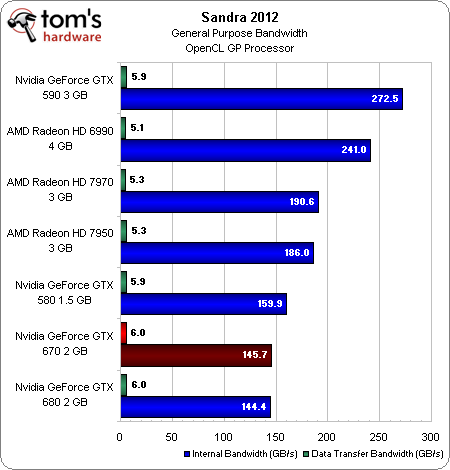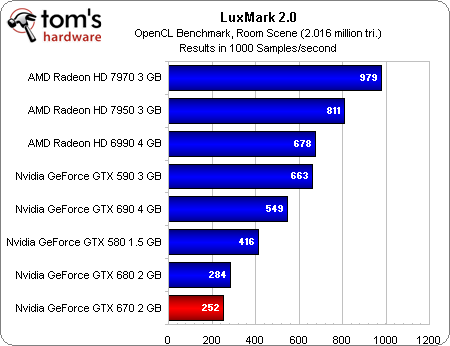GeForce GTX 670 2 GB Review: Is It Already Time To Forget GTX 680?
Not like it was ever really widely available anyway, right? The GeForce GTX 670 offers most of GK104's on-chip resources, doesn't give up much performance, and costs $100 less. Now, let's see if Nvidia can make enough of them to satisfy demand.
Benchmark Results: Sandra 2012 And LuxMark 2.0
For all of their alacrity in gaming, the Kepler-based GeForce products demonstrate an evolutionary step forward in FP32 throughput and a more jarring slow-down in double-precision floating-point math. Meanwhile, AMD’s GCN architecture propels Tahiti forward in compute workloads.
Sandra 2012 helps quantify AMD’s gains and Nvidia’s willing compromise. The only cards GeForce GTX 670 beats in floating-point math are older Fermi-based boards. Meanwhile, the new 670 takes last place in FP64.
Leaning on this diagnostic tool again shows us bandwidth between the GPU and its memory, along with throughput over the PCI Express bus. Extremely low data transfer numbers across the board represents poor performance from the X79 platform. Meanwhile, internal bandwidth reflects on the 384-bit aggregate memory bus AMD uses on its Radeon HD 7900-series cards, along with the 256-bit interface Nvidia’s employs on its GeForce GTX 600s. GeForce GTX 690 seems to break this test, returning a bad GP call.
Applying those theoretical numbers from Sandra to a real-world-based test like LuxMark paints a pretty telling picture. AMD’s cards absolutely dominate. The slowest, Radeon HD 6990, even manages to beat the fastest Nvidia board—ironically, the old GeForce GTX 590.
Truly, we’re interested to see how Nvidia plans to address compute on the desktop after making such a big deal about it last generation. Might the company have plans to sell you a separate compute-oriented upgrade?
Get Tom's Hardware's best news and in-depth reviews, straight to your inbox.
Current page: Benchmark Results: Sandra 2012 And LuxMark 2.0
Prev Page Benchmark Results: Metro 2033 (DX 11) Next Page Benchmark Results: MediaEspresso 6.5-
tecmo34 Great Review Chris!!Reply
Though there isn't really a performance hit but it would be great to have seen the GTX 670 running at PCIe 3.0. -
master9716 OMFG no 5760x1080 benchmarks again?!! ima have to go to hardware.info or something wow!Reply -
gilgamex101 "Dude.......seriously!?........you sure?.......wait wait, what about image qual--.....no......looks fine.........awwww.......AWWWWWWW !@#$......!@#$.........!@#$ !^&* *&^%$#@!@.....and you !$%^*(......green peice of !@#$%............GREAT.......JUST BEAUTIFUL.....- AMD in response to 670 GTX reviewsReply -
rglaredo I hate Nvidia and their supply and demand game ...it is obvious that they are just holding off the cards to inflate the prices...I'm going with AMD ....because I'm tired of waiting ...I'm not going to wait anymore ..Reply -
sayantan Nice move nV , forcing AMD to drop their prices for entire lineup. A 7970 at $400 would be really awesome...Reply -
godfather666 The list of games is very unfair to AMD cards. Techpowerup's review, which featured a much longer list of games, had the Radeon HD 7970 faster than the GTX 670 at all resolutions 1080p and higher.Reply
Nvidia has had a big lead in Dirt 3 and WoW for a very long time. This skews the results.
The GTX 670 is a fantastic card, don't get me wrong. Just pointing out that it's being slightly overrated here.



